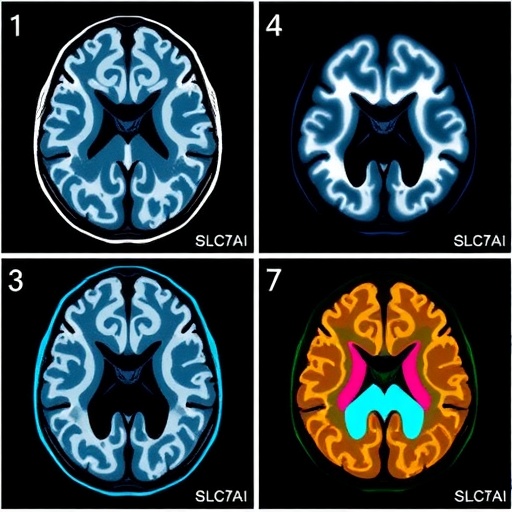In a groundbreaking study that could reshape the therapeutic landscape for aggressive brain tumors, researchers have identified the amino acid transporter SLC7A1 as a pivotal target in high-grade meningioma treatment. High-grade meningiomas, notorious for their aggressive behavior and resistance to conventional therapy, have remained a clinical challenge. The latest research uncovers molecular insights that promise new directions for targeted interventions.
High-grade meningiomas, classified as WHO grade II and III tumors, represent a subset of meningiomas with high recurrence rates and poor prognosis. Unlike their benign counterparts, these tumors exhibit invasive growth patterns and often resist standard treatments such as surgery and radiation. The discovery of actionable molecular targets within these tumors has been elusive, but the focus on cellular metabolism and nutrient transporters has recently gained momentum, with SLC7A1 emerging as a molecule of interest.
SLC7A1, a member of the solute carrier family, functions primarily in the transport of cationic amino acids such as arginine and lysine across the plasma membrane. Amino acids are not only critical for protein synthesis but also serve as metabolic substrates in proliferating tumor cells, sustaining their energetic and biosynthetic demands. The overexpression of transporters like SLC7A1 in malignant tissues underscores an adaptive mechanism that tumors deploy to survive and thrive in nutrient-deprived microenvironments.
The study conducted by Song and colleagues leverages a multidisciplinary approach encompassing transcriptomic profiling, immunohistochemistry, and functional assays to establish the role of SLC7A1 in high-grade meningioma pathobiology. Their findings articulate a compelling narrative where enhanced SLC7A1 expression correlates with tumor grade and aggressiveness, suggesting its utility as both a biomarker and therapeutic target.
Detailed molecular analyses revealed that SLC7A1 is significantly upregulated in high-grade meningioma tissues compared to low-grade and normal meningeal tissues. This differential expression pattern was consistent across patient-derived samples, underscoring the clinical relevance of the transporter. The localization of SLC7A1 to the tumor cell membrane further implicates its direct involvement in nutrient uptake essential for tumor cell proliferation.
Functional perturbation studies using RNA interference to knock down SLC7A1 in meningioma cell lines resulted in marked reductions in cell proliferation, migration, and invasion capabilities. These assays demonstrate that blocking SLC7A1 disrupts the tumor cells’ metabolic homeostasis, leading to impaired growth dynamics. Importantly, the inhibition of SLC7A1 sensitized tumor cells to chemotherapeutic agents, highlighting its potential as a combinatorial target.
At a mechanistic level, depletion of SLC7A1 hindered the uptake of arginine, a semi-essential amino acid that feeds into the urea cycle and nitric oxide synthesis, pathways integral to cell survival and angiogenesis. This disruption caused metabolic stress within tumor cells, triggering apoptosis and cell cycle arrest. The data suggest that SLC7A1-mediated arginine transport constitutes a metabolic vulnerability in high-grade meningioma.
The researchers also employed in vivo models to validate the therapeutic promise of targeting SLC7A1. Meningioma xenografts with attenuated SLC7A1 expression demonstrated significant tumor growth retardation and reduced invasiveness. These preclinical models provide a crucial translational bridge, reinforcing the feasibility of targeting SLC7A1 in clinical settings.
From a therapeutic development perspective, molecules inhibiting amino acid transporters have been explored in other cancer types, but specificity and toxicity concerns have limited progress. The identification of SLC7A1 as a tumor-selective transporter in meningioma opens new avenues for designing selective inhibitors or antibody-drug conjugates that could minimize off-target effects and maximize antitumor efficacy.
The implications of this study extend beyond the immediate context of meningioma. Tumor metabolism, particularly amino acid transport, has emerged as a versatile target in oncology, with SLC family members contributing to tumor growth in various cancers. The findings from this research contribute to a broader paradigm where metabolic vulnerabilities are exploited to overcome therapeutic resistance in refractory tumors.
This research also highlights the importance of integrated omics approaches in cancer biology. By correlating gene expression profiles with functional assays, the study offers a robust framework for identifying and validating novel therapeutic targets. Such strategies are critical for advancing precision oncology and tailoring treatments based on molecular tumor characteristics.
While this study significantly advances our understanding of meningioma biology, challenges remain for clinical translation. The heterogeneity of meningiomas poses obstacles in uniformly targeting SLC7A1, necessitating the development of companion diagnostics to stratify patients likely to respond to such therapies. Moreover, long-term studies are needed to assess potential resistance mechanisms and optimize combinatorial treatment regimens.
In summary, the identification of SLC7A1 as a critical player in high-grade meningioma metabolism and progression marks an exciting milestone in neuro-oncology research. Targeting this amino acid transporter holds promise for improving outcomes in patients suffering from these aggressive tumors with limited treatment options. As further studies build upon these foundational findings, SLC7A1 may well emerge as a linchpin in future therapeutic strategies.
In an era where cancer treatment increasingly hinges on unraveling molecular intricacies, the discovery detailed by Song et al. reflects the power of targeted research to illuminate new frontiers. High-grade meningiomas have long defied effective treatment, but unlocking metabolic vulnerabilities such as reliance on SLC7A1 may turn the tide against this formidable disease.
The road ahead will involve optimizing SLC7A1 inhibitors and integrating metabolic targeting with current treatment modalities such as radiation and immunotherapy. Collaborative efforts across translational science disciplines are essential to propel these findings from bench to bedside, ultimately enhancing patient survival and quality of life.
This study exemplifies the dynamic interplay between tumor metabolism and therapeutic innovation. As the oncology field continues to embrace metabolic targets, discoveries like the role of SLC7A1 in high-grade meningioma reiterate the importance of exploring fundamental biological pathways to devise effective cancer therapies.
Subject of Research: High-grade meningioma, amino acid transporter SLC7A1, tumor metabolism, therapeutic targeting
Article Title: Identification of SLC7A1 as a potential therapeutic target for high-grade meningioma
Article References:
Song, L., Li, X., Li, D. et al. Identification of SLC7A1 as a potential therapeutic target for high-grade meningioma. Cell Death Discov. 11, 498 (2025). https://doi.org/10.1038/s41420-025-02783-4
Image Credits: AI Generated
DOI: 03 November 2025




